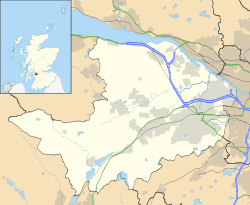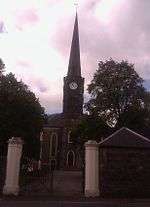Johnstone
| Johnstone | |
| Scottish Gaelic: Baile Iain | |
| Scots: Johnstoun | |
 Johnstone |
|
| Population | 15,687 [1] |
|---|---|
| OS grid reference | NS434628 |
| Council area | Renfrewshire |
| Lieutenancy area | Renfrewshire |
| Country | Scotland |
| Sovereign state | United Kingdom |
| Post town | JOHNSTONE |
| Postcode district | PA5 |
| Dialling code | 01505 |
| Police | Scottish |
| Fire | Scottish |
| Ambulance | Scottish |
| EU Parliament | Scotland |
| UK Parliament | Paisley and Renfrewshire South |
| Scottish Parliament | Renfrewshire South |
Coordinates: 55°50′05″N 4°30′10″W / 55.83461°N 4.50272°W
Johnstone (Scots: Johnstoun,[2] Scottish Gaelic: Baile Iain)[3] is a town in the council area of Renfrewshire and larger historic county of the same name in the west central Lowlands of Scotland.
The town lies 3 miles (5 km) west of neighbouring Paisley and 12 miles (19 km) west of the centre of the city of Glasgow and 12 miles (19 km) north east of Kilwinning [4] Part of the biggest conurbation in Scotland, Johnstone is at the western edge of the Greater Glasgow Urban Area.
History
Johnstone was largely a planned community which grew up around the house of Easter Cochrane, later known as Johnstone Castle, seat of the Houston or Houstoun family who gained their name from the nearby village of Houston. In 1782, the Laird, George Houstoun, commissioned designs for a series of regular residential streets which now form the town centre. At this early stage of development, the town’s population including the local estate and rural hinterland was around 1,500.[4] Two mirroring civic squares were also constructed in the town: Houstoun Square and Ludovic Square,[5] and by 1794 the town had gained its current parish church.[6] Johnstone was raised to the status of a police burgh with significant local powers, a status which is now defunct.[6]

Industrial development brought both prosperity and poverty to the community. Coal mining occurred in Johnstone, although its main industry was related to the thread and cotton industries, with mills powered by the Black Cart Water which runs to the north of Johnstone.[5] As the community expanded, slum conditions formed in part of the town: the population by 1831 had increased to a sizeable 5,600.[4] This was addressed in the 1930s by a significant expansion of the size of Johnstone to include a number of purpose-built residential estates.
Much of Johnstone’s feudal heritage has disappeared. With the death of the last Laird in 1931, Johnstone Castle found some other uses before falling into disrepair and being largely demolished.[4]
Education

Thorn Public School, as it was originally called, opened in 1904 on a site that is now occupied by a housing estate, Thornhill Gardens and was demolished in 1990 and a new Thorn Primary School opened in 1988.
In 1950 St. David's Primary School was built along with its sister school Cochrane Castle Primary School. In 2007 the two schools were housed in a new shared building just outside Thomas Shanks Public Park. Embedded within Cochrane Castle is the Cochrane Castle Golf Club, which once held the world record for the longest hole.
Johnstone High School opened on its present site in March 1965, the previous building having burnt down in 1960. Where the old school stood in Ludovic Square there is now a modern health centre. The original St Cuthberts High School was built adjacent to Johnstone High School and shared the same driveway and car parks. The school closed in 1972 and moved to a new site in Hallhill Road Spateston that year. The original school was demolished and replaced by a housing development to the left of the driveway of Johnstone High School.. In 1967 St. Cuthbert's High School[7] was built and established. The school closed at the end of the summer term 2006 along with St. Brendan's High School in Linwood due to falling rolls and the buildings' poor state of repair. These were replaced by a new build St. Benedict's High School named in honour of St Benedict of Nursia the patron saint of Europe and of students. The old St. Cuthbert's building was used to house several schools (including Johnstone High School) while their own premises are being refurbished, but the building has now been demolished.
Transport
 |
Brookfield | Linwood | Paisley |  |
| Kilbarchan | |
Elderslie | ||
| ||||
| | ||||
| Howwood | Gleniffer Braes | Gleniffer Braes |
Air
Johnstone is served by Glasgow International Airport, which is located 3 1⁄2 miles (5.6 km) northeast of the town. Moreover, Prestwick International Airport is a 30-to-40-minute train journey from Johnstone railway station.
Road
A dual carriageway, the A737 connects Johnstone to the M8 motorway to provide car transport links to central Scotland.
Bus Services
McGill's Bus Service Limited operate the majority of local services from their depot in the west end of Johnstone.
Key Coaches are a local service operator based in Elderslie.
- X6a Johnstone – Glasgow : Express service via Braehead
- 1: Johnstone – Kilmacolm : formerly Riverside Transport
- 8: Johnstone – Linwood Circular : formerly Riverside Transport (renumbered)
- 19 Johnstone Station – Bridge of Weir – Houston – Inchinnan Industrial Estate – Paisley : formerly Riverside Transport
- 20: Spateston-Johnstone Centre-Paisley-Gallowhill (via Elderslie and the Royal Alexandria Hospital)
- 38: Spateston/Kilbarchan-(Cochrane Castle which is on the Spateston Route)- Johnstone Centre - Paisley - Glasgow
- 904: (Hourly Service) Largs - Kilbirnie - Beith - Howwood - Johnstone - Paisley
Other services are provided by many other operators. They are as follows:
- 1: Johnstone – Johnstone Castle : Key Coaches
- 4: Johnstone – Lochwinnoch : Key Coaches
- 5: Johnstone – Spateston : Key Coaches
- 307: Johnstone – Lochwinnoch : McColl's
Rail
Johnstone is linked to Glasgow Central, Paisley and the Ayrshire coast by the Johnstone railway station which is located at the east of the town on Thorn Brae. A second unmanned station Milliken Park railway station lies at the west end of the town, just off the Cochranemill road. The railway line runs through the cutting of the old Glasgow-Ardrossan canal, although the route of the canal runs under the original bridge, Dick's Bridge, at the bottom of the Thorn Brae, where the canal basin was situated and in winter, the rim of the canal basin sometimes becomes visible.
It may be noted that a second railway line ran through the town serving the villages of Kilbarchan, Bridge of Weir, and Kilmacolm; the line now forms part of the Clyde to Forth cycle route (National Cycle Route 75). It had a station serving the Northern, more industrial areas of town, Johnstone North railway station.
Notable inhabitants
- William Clunas (Billy Clunas.) April 1899~September 1967. Scotland and Sunderland footballer. Played in the first England V's Scotland match at Wembley Stadium 1924
- Johnny Grant (Jock Strap), vocalist of 70s punk band The Straps, born 1960 and grew up in Johnstone Castle.
- Adam Brown - Professional Hockey Player; born in Johnstone 02/04/1920, active in the NHL 1941-1952.
- Tommy Bryce – professional footballer
- Hunter Davies – journalist, author and broadcaster
- Robert Pollock Gillespie FRSE - mathematician
- Renee Houston – music hall and comedy actress; born in Johnstone in 1902, attended St. Margaret's Primary School in Johnstone
- Phyllis Logan – actress; attended Johnstone High School in the 1970s
- John Pitcairn, Jr. – Scottish-American industrialist; born in Johnstone, emigrated to the United States, aged five
- Gordon Ramsay – celebrity chef and TV host, born in Johnstone
- Peter Tobin – serial killer, born in Johnstone in 1946
- Jim Leighton – professional footballer, attended St.Cuthbert's Secondary in Johnstone
- Annie McGuire – BBC Journalist, born in Elderslie, attended St.Cuthbert's Secondary in Johnstone
- Kenneth McLachlan – Substitute goalkeeper and local pie eating champion
- Sir George Houston Reid – 4th Prime Minister of Australia. 18 August 1904 – 5 July 1905 George Reid was Prime Minister for ten months and 17 days. He was Australia's first federal Leader of the Opposition and the federal government’s first High Commissioner to the UK.
- Tommy Turner – professional footballer
- John Deans – professional footballer
- Eddie Blair – Jazz Session trumpeter, in the Big Bands of the 50's and 60's including: The John Dankworth 7, Ted Heath Orchestra and The Ronnie Hazelhurst Orchestra throughout the 70's and 80's as well as for the big screen, notably the trumpet solo 'Take Me Home' from the James Bond film 'For Your Eyes Only'.
- Alexander McLachlan - Poet, who was born at the Brig in 1818.
- Sir William Arrol - Worked as a boy at the Johnstone mills before becoming the architect of the Forth Rail Bridge and the Tower Bridge in London.
- Dougie Vipond - Born Douglas Vipond, 15 October 1966, Elderslie, is a Scottish musician and television personality. He studied at the Royal Scottish Academy of Music and Drama, graduating in 1985. He was one of the founding members of Scottish soft rock / pop band, Deacon Blue.
- Richard Madden - Born in Elderslie on June 18, 1986. Madden grew up in Elderslie, Scotland. His mother, Pat, is a classroom assistant, and his father, Richard, is in the fire service. He has two sisters - Cara and Lauren. At the age of 11, he joined Paisley Arts Centre's youth theatre programme to help overcome his shyness. He was soon cast as young Andy in the film adaptation of Iain Banks's Complicity, followed by his being cast in a lead role as Sebastian in the television series Barmy Aunt Boomerang, for which he filmed 6 episodes that aired from 1999 until 2000. He graduated from the Royal Scottish Academy of Music and Drama in 2007.
See also
External links
References
- ↑ Renfrewshire Community Website – Johnstone
- ↑ List of railway station names in English, Scots and Gaelic – NewsNetScotland
- ↑ Ainmean-Àite na h-Alba ~ Gaelic Place-Names of Scotland
- 1 2 3 4 5 (Our History and Heritage) Homepage
- 1 2 Visiting Renfrewshire
- 1 2 University of Edinburgh
- ↑ T2TW: Home take2theweb – Community Websites for Schools
